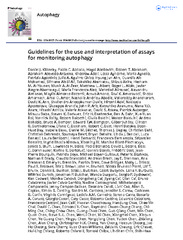Приказ основних података о документу
Guidelines for the use and interpretation of assays for monitoring autophagy
| dc.creator | Klionsky, Daniel J. | |
| dc.creator | Trajković, Vladimir S. | |
| dc.date.accessioned | 2018-03-01T22:33:47Z | |
| dc.date.available | 2018-03-01T22:33:47Z | |
| dc.date.issued | 2012 | |
| dc.identifier.issn | 1554-8627 | |
| dc.identifier.issn | 1554-8635 | |
| dc.identifier.uri | https://vinar.vin.bg.ac.rs/handle/123456789/4894 | |
| dc.description.abstract | In 2008 we published the first set of guidelines for standardizing research in autophagy. Since then, research on this topic has continued to accelerate, and many new scientists have entered the field. Our knowledge base and relevant new technologies have also been expanding. Accordingly, it is important to update these guidelines for monitoring autophagy in different organisms. Various reviews have described the range of assays that have been used for this purpose. Nevertheless, there continues to be confusion regarding acceptable methods to measure autophagy, especially in multicellular eukaryotes. A key point that needs to be emphasized is that there is a difference between measurements that monitor the numbers or volume of autophagic elements (e.g., autophagosomes or autolysosomes) at any stage of the autophagic process vs. those that measure flux through the autophagy pathway (i.e., the complete process); thus, a block in macroautophagy that results in autophagosome accumulation needs to be differentiated from stimuli that result in increased autophagic activity, defined as increased autophagy induction coupled with increased delivery to, and degradation within, lysosomes (in most higher eukaryotes and some protists such as Dictyostelium) or the vacuole (in plants and fungi). In other words, it is especially important that investigators new to the field understand that the appearance of more autophagosomes does not necessarily equate with more autophagy. In fact, in many cases, autophagosomes accumulate because of a block in trafficking to lysosomes without a concomitant change in autophagosome biogenesis, whereas an increase in autolysosomes may reflect a reduction in degradative activity. Here, we present a set of guidelines for the selection and interpretation of methods for use by investigators who aim to examine macroautophagy and related processes, as well as for reviewers who need to provide realistic and reasonable critiques of papers that are focused on these processes. These guidelines are not meant to be a formulaic set of rules, because the appropriate assays depend in part on the question being asked and the system being used. In addition, we emphasize that no individual assay is guaranteed to be the most appropriate one in every situation, and we strongly recommend the use of multiple assays to monitor autophagy. In these guidelines, we consider these various methods of assessing autophagy and what information can, or cannot, be obtained from them. Finally, by discussing the merits and limits of particular autophagy assays, we hope to encourage technical innovation in the field. | en |
| dc.relation | National Institutes of Health Public Health Service [GM53396], ICREA | |
| dc.rights | openAccess | en |
| dc.source | Autophagy | en |
| dc.subject | autolysosome | en |
| dc.subject | autophagosome | en |
| dc.subject | flux | en |
| dc.subject | LC3 | en |
| dc.subject | lysosome | en |
| dc.subject | phagophore | en |
| dc.subject | stress | en |
| dc.subject | vacuole | en |
| dc.title | Guidelines for the use and interpretation of assays for monitoring autophagy | en |
| dc.type | review | en |
| dcterms.abstract | Трајковиц, Владимир; Клионскy, Даниел Ј.; | |
| dc.citation.volume | 8 | |
| dc.citation.issue | 4 | |
| dc.citation.spage | 445 | |
| dc.citation.epage | 544 | |
| dc.identifier.wos | 000305403400002 | |
| dc.identifier.doi | 10.4161/auto.19496 | |
| dc.citation.rank | M21a | |
| dc.identifier.pmid | 22966490 | |
| dc.contributor.count | (ukupan broj autora: 1268) | |
| dc.identifier.scopus | 2-s2.0-84862295360 | |
| dc.identifier.fulltext | https://vinar.vin.bg.ac.rs/bitstream/id/6332/bitstream_6332.pdf |

